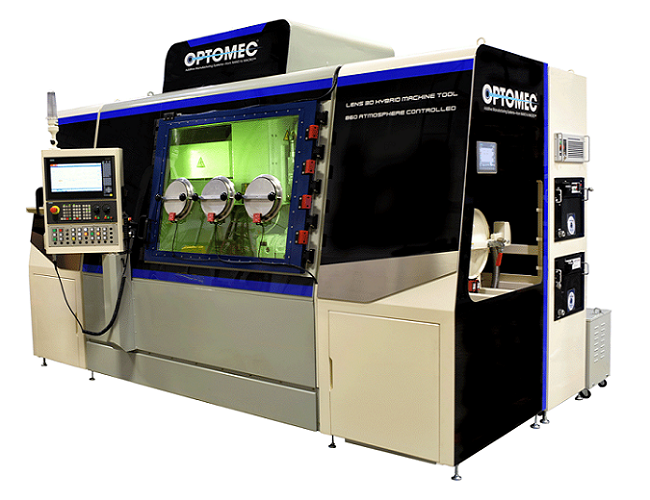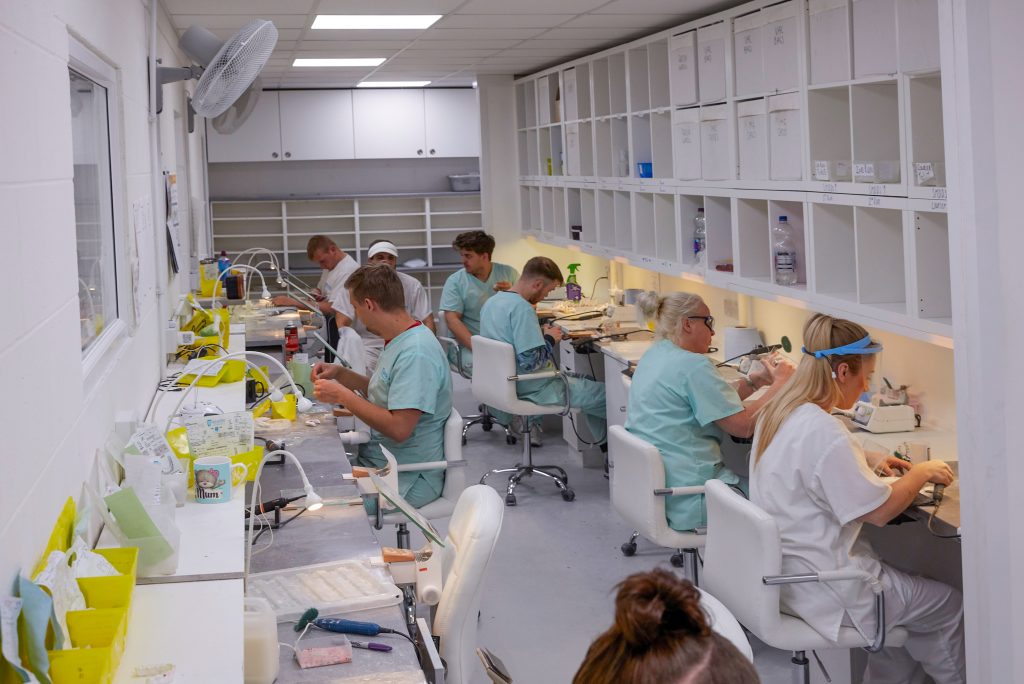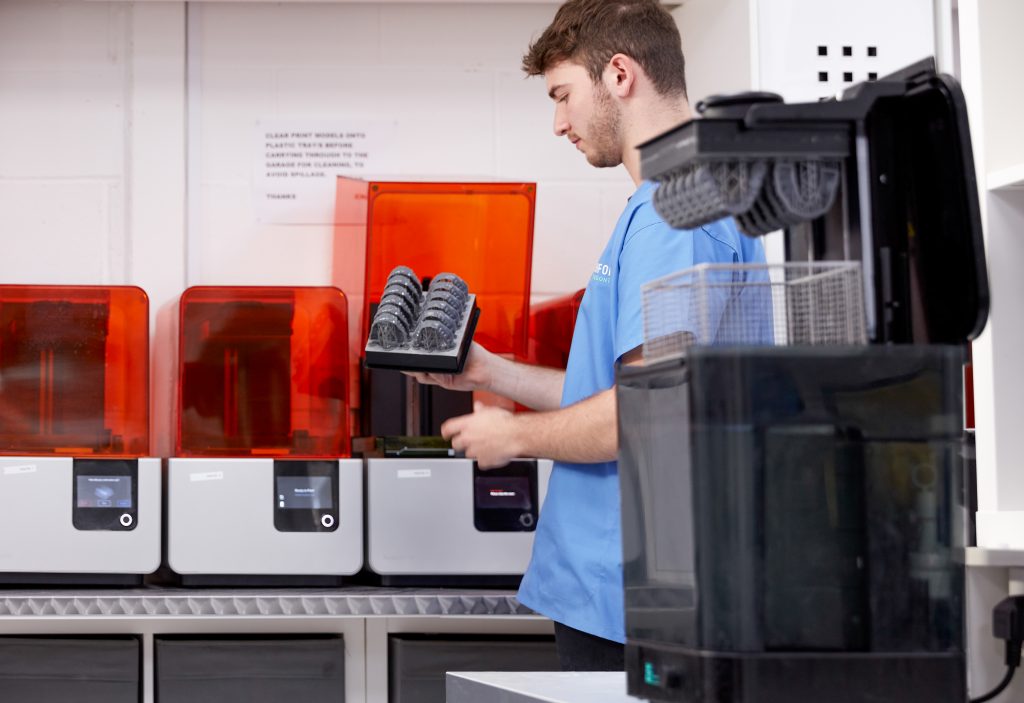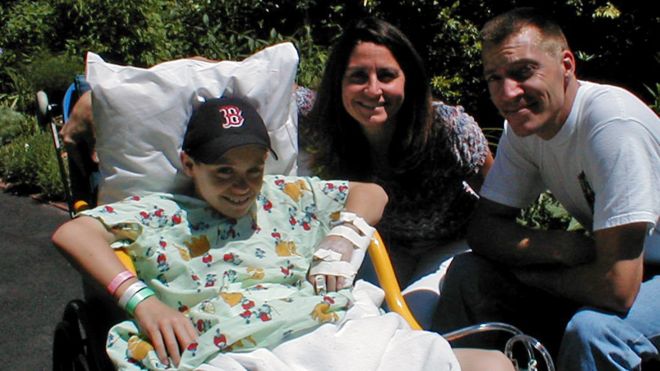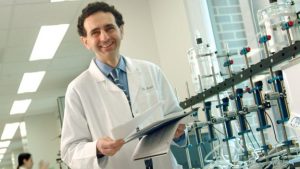Day Two of 3D printing at IMTS, smart factories and preparing for serial production
Optomec releases hybrid additive manufacturing system for reactive metals with medical potential
Optomec Introduces New Hybrid 3D Printing System, Used By Researchers to Make Dissolvable Magnesium Medical Implants
![]() New Mexico-based Optomec is well-known for both its aerosol jet technology, which is used to 33D print electronics, and its other patented AM process: LENS, which uses Directed Energy Deposition (DED) for high-value metal 3D printing. The company has been busy in the last few years, winning contracts and awards and providing resources on its technologies. In 2016, the company first showcased its hybrid LENS Machine Tool series, which consist of a CNC Vertical Milling platform integrated with Optomec’s proprietary LENS metal 3D printing technology.
New Mexico-based Optomec is well-known for both its aerosol jet technology, which is used to 33D print electronics, and its other patented AM process: LENS, which uses Directed Energy Deposition (DED) for high-value metal 3D printing. The company has been busy in the last few years, winning contracts and awards and providing resources on its technologies. In 2016, the company first showcased its hybrid LENS Machine Tool series, which consist of a CNC Vertical Milling platform integrated with Optomec’s proprietary LENS metal 3D printing technology.
This week at IMTS 2018 in Chicago, Optomec is introducing the latest addition to the series – the LENS 860 Hybrid Controlled Atmosphere (CA) System.
“The new LENS 860 suite of systems builds on the success of our Machine Tool Series, first launched at IMTS in 2016,” said Dave Ramahi, Optomec President and CEO. “These new larger machines continue to demonstrate our ability to transition Optomec production-proven 3D Metal Printing capability onto traditional CNC platforms that match the cost, performance and ease-of-use demands of the traditional machine tool market. These products are a key element of our strategy to bring Metal Additive Manufacturing into the industrial mainstream.”
The new large-format LENS 860 Hybrid CA System offers more capabilities for high-quality, affordable metal hybrid manufacturing, thanks to its higher laser power support and larger build volume of 860 x 600 x 610 mm. It features a hermetically-sealed build chamber that maintains moisture and oxygen levels below 10 ppm for processing reactive metals, like titanium, and can cost-effectively produce and repair parts.
The system offers versatility, as it can perform wide area cladding for wear coating applications and 3D print fine, detailed features for thin wall metal structures. It can also be configured with a high-power 3kW fiber laser and closed loop controls, which makes it the perfect choice for building, repairing, and coating mid- to large-size parts that offer superior metal quality. Optomec’s powerful software allows for 5-axis build strategies, which can combine both subtractive and additive operations in one tool path; the company also provides several material starter recipes to speed up adoption with the LENS 860 Hybrid CA System.
Performing finish machining on a 3D printed part with the LENS Hybrid configuration’s milling capability, without having to align it on another machine or re-fixture it, is one of the many advantages of the LENS Machine Tool Series, which start at under $250,000. There are three additional configurations to the LENS 860 Hybrid CA System model in the series: two Additive-Only models, both of which are Open and Controlled Atmosphere, and and the 860 Hybrid Open Atmosphere (OA) system, which is a good platform to use when processing non-reactive metals like Tool Steel Inconel and Stainless Steel.
 You can see the new system for yourself this week at Optomec’s booth #432204 in the West Building at IMTS 2018. The first customer shipments of the LENS 860 Hybrid CA System will take place later this year.
You can see the new system for yourself this week at Optomec’s booth #432204 in the West Building at IMTS 2018. The first customer shipments of the LENS 860 Hybrid CA System will take place later this year.
Speaking of customers, Optomec also shared the details at IMTS of how the University of Nebraska-Lincoln (UNL) is using one of its new LENS Hybrid CA Systems to create dissolvable magnesium components for applications in the medical field.
Medical implants, like screws and plates, made of stainless steel or titanium, are permanent structures that can have high complications rates and need to be surgically removed and fixed. But the university’s work with the LENS Hybrid CA System will allow the creation of 3D printed, patient-specific implants with a controlled time to dissolve, which will lower the costs, risks, and suffering of patients who will no longer require a second surgery to remove implants.
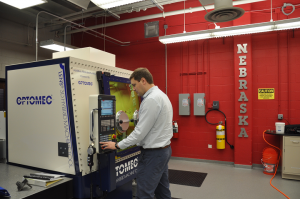
Professor Mike Sealy of UNL and his team are using an Optomec LENS Hybrid CA System to advance the performance and functionality of medical implants.
“We are proud to be the first customer of an Optomec LENS Hybrid Controlled Atmosphere System, the only commercially-available machine to provide hybrid manufacturing capabilities for reactive metals. Our research is focused on advancing the performance and functionality of dissolvable devices. Using LENS, we are applying a hybrid additive manufacturing process to control the disintegration of medical fasteners and plates so they stay in-tact long enough to serve their purpose and then degrade away once the bone is healed,” said Dr. Michael Sealy, Assistant Professor of Mechanical and Materials Engineering at UNL, and a pioneer in advanced manufacturing research.
Optomec’s LENS 3D Hybrid CA System is the AM industry’s first atmosphere-controlled system for additive and subtractive processing of metals, and combines the company’s industry-proven LENS technology with a strong CNC automation platform. The system will make it more cost-effective to introduce metal 3D printing to industrial markets.
The UNL is a 3D printing and hybrid AM leader, and using the LENS Hybrid CA System allows Dr. Sealy and his team to combine layered surface treatments with LENS technology in order to 3D print magnesium components with controlled degradation – a coveted design capability in the medical field, in addition to areas like automotive structures and lightweight aerospace. Whereas dissasolvable and bioabsorbable 3D printed polymers have been shown dissovable metals is completely new.
“Two years ago, at IMTS in 2016, Dr. Sealy and his team at University of Nebraska became the first customer of our LENS Hybrid Controlled Atmosphere system. Today they are here at IMTS showcasing their groundbreaking accomplishments achieved with their LENS Hybrid system,” said Tom Cobbs, LENS Product Manager at Optomec. “Dr. Sealy’s pioneering work enables the design and manufacture of components with a combination of properties unobtainable using traditional metal working methods. We applaud his innovative use of hybrid additive manufacturing to create and qualify a new class of metal components with unique properties that will benefit mankind.”
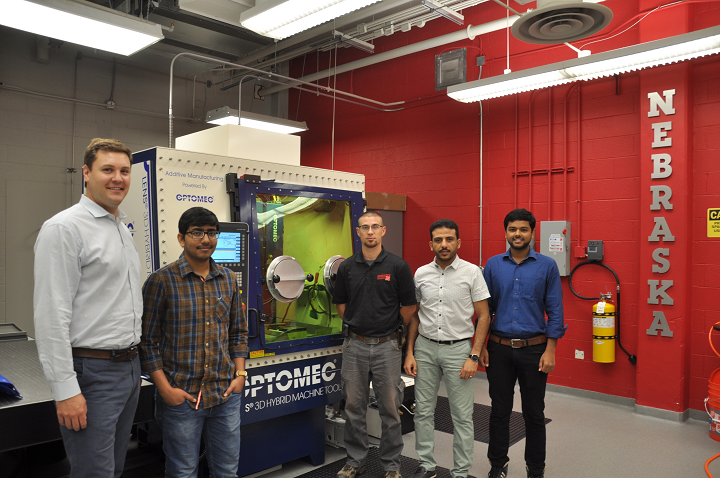
Dr. Mike Sealy and UNL students have been using a LENS metal hybrid AM system from Optomec to advance research in key areas such as heavy machinery, medical devices, and aeronautics.
Reactive materials and powdered metals, such as titanium and magnesium, have to be processed in a controlled atmosphere, where oxygen and moisture impurities can be kept below 10 parts per million. Dr. Sealy used the Optomec LENS 3D Hybrid CA System to process these kinds of materials in a way that allowed a degradable implant to hang onto its integrity and strength long enough to complete its job. He is also working with Sentient Science to investigate hybrid processing techniques of 7000 series aluminum for the US Navy.
Discuss this and other 3D printing topics at 3DPrintBoard.com or share your thoughts below.
[Images provided by Optomec]
Ashford Orthodontics Uses 3D Printing to Help Dental Offices Go Fully Digital
The largest orthodontic laboratory in the United Kingdom is Ashford Orthodontics, which was founded in 2001 by Sean Thompson in his garage after several years working in the Orthodontic and Maxillofacial Department at Sunderland Royal Hospital. Thompson started the company after noting that there was a growing demand for orthodontic devices but a shortage of high quality laboratories offering specialized orthodontic technical services. His business quickly grew, and he was joined by fellow orthodontic technicians Craig Stevens and Graeme Winyard. Now the lab is 12,000 square feet and has more than 50 employees.
Five years ago, Ashford Orthodontics started looking into digital orthodontic practices.
“Digital orthodontics was something we knew we had to get into,” said Thompson. “We couldn’t afford not to do it if we really wanted to be a leading player within orthodontics. We wanted to be an early implementer. Any business has to plan four or five years ahead, and you don’t want to be left behind when others are moving on.”
The company then bought a Formlabs Form 2. They started off with one of the printers, and are now up to 12.
There are now eight digital technologists in the company’s digital department, managing the 12 Form 2 3D printers.
“The Form 2 is very reliable; we call it a workhorse,” Thompson continued. “We know when we go home at night that when we come in in the morning, everything will be printed. There’s not going to be a failure; everything will be there. Because of that, we can build our business around them.”
Every day, the lab has a working cutoff time of about 3:00 PM. The technicians review new scans sent in by clients, then plan out treatments and set the necessary parts, such as aligners, to 3D print overnight. In the morning, a technician cleans and dries the 3D printed parts, after which another technician thermoforms the clear aligners on the finished models. By the time most of the other technicians arrive, the aligners are ready for post-processing.
“Once you’ve got a model to work on, there’s very little difference,” said Thompson. “If you are a traditional lab and you want to go and push the boundaries to digital, once you’ve done the learning side of it, the manufacturing side is pretty similar.”
In the afternoon, the finished aligners are packaged and sent to the clinicians, arriving within 48 hours.
“It works absolutely perfect for us,” said Thompson. “We launch the printers just before we go home at night; that’s our night shift. We come in the next morning and by then, the night shift has done their job. It doesn’t matter if they’re sitting there for two hours, four hours, six hours—it’s done. We totally rely on that coming in on the morning, so it’s the quality and reliability of the print that matters to us.”
Having multiple 3D printers helps, as does their large build platforms.
“It’s quite easy for us just spread a few models along 10 or 12 printers and have them printed in a couple of hours. So if we do need to do quick runs, we can accommodate them across all the printers instead of putting them all on one. We find that that works very well for our business.”
The lab can also store digital models online and access them at any time, which is helpful when things like retainers need to be replaced.
“There’s no time lapse due to a child breaking or losing their retainer and having to go to the dentist to get a new impression,” said Thompson. “Teeth are drifting all the time and relapse is happening. We can just pull the file from the cloud—where we store them basically for free—print the model, create the appliance, and even send it directly to the patient.”
The lab can also reuse the same 3D model to create multiple appliances if necessary.
“A common trend now is to debond the brackets and instantly fit all the retention products chairside,” Thompson said. “By removing the brackets digitally, we can make an Essix, bonded, or a Hawley retainer, and a whitening tray all on the same model which simply isn’t possible via the traditional route and plaster models.”
Ashford Orthodontics has been able to pass on cost and time savings to their clients by going digital.
“It shouldn’t cost you any more to provide your services to your clients and patients via the digital route than via the traditional impression route,” said Thompson. “So what we’ve done is quite simply that we swapped the cost of the plaster models—which aren’t needed anymore—with the cost of the resin model. Therefore, your lab bill is exactly the same, whether it’s done via the traditional route or the digital route, except you can have things back 24 hours sooner.”
The company has become a trusted provider that attracts customers from the UK as well as all over the world.
“We’ve got new clients coming to us every day, who have never used us before, so they don’t know if the quality is going to be good or if the customer service is going to be reliable,” said Thompson. “When they realize that what we’re providing here is very good quality, they trust us to send us the more complex appliances. So invariably, within two months of getting a new client who wants to use our services for digital orthodontics, they start asking if we can do twin blocks, fixed appliances, or functionals. Before we know it, they’re sending us lots and lots of work, because we can accommodate all of their needs.”
Ashford now provides digital services to three practices that have no impression materials in their offices – they’ve gone fully digital, thanks to the services of the lab.
“When we first started with the digital side of things, it accounted for maybe two percent of our business,” said Thompson. “Just this last month it’s around 15 percent, and it is the fastest growing sector within the laboratory. “At the moment, it’s traditional techniques with a little bit of digital, but in a matter of two or three years, it’s going to be digital techniques with a little bit of traditional. And that’s going to be the driving force for our department moving forward.”
Discuss this and other 3D printing topics at 3DPrintBoard.com or share your thoughts below.
[Images: Formlabs]
SwRI and UTSA to develop 3D printed medical implant for slow-release cancer medication
3D Bioprinting Makes Progress as Lab-Grown Bladder Helps Young Man to Lead a Normal Life
Luke Massella was born with spina bifida, a condition that left a gap in his spine. By the age of 10, he had undergone a dozen surgeries and, contrary to doctors’ expectations, was able to walk. But then his bladder malfunctioned, causing his kidneys to fail.
“I was kind of facing the possibility I might have to do dialysis for the rest of my life,” he says. “I wouldn’t be able to play sports, and have the normal kid life with my brother.”
Dr. Anthony Atala of Boston Children’s Hospital had a better idea. He took a small piece of Massella’s bladder and, over the course of two months, grew a new organ in the lab. The new bladder was transplanted into the patient in a 14-hour surgery and, according to Massella, he has been able to live a normal life since then. Now 27, Massella underwent 17 surgeries before he was 13, but has not had to have a single operation since then.
Dr. Atala is an expert in bioprinting, and he and his team have developed eight cell-based tissues that they have transplanted into patients. These include skin, urethras and cartilage grown in the lab. The organs are currently going through clinical trials for approval by the US Food and Drug Administration.
“You need to know how to make these organs by hand, then the bioprinter is really a scale-up tool,” said Dr. Atala, now Director of the Wake Forest Institute for Regenerative Medicine in North Carolina.
According to Dr. Atala, the easiest structures to 3D print are flat structures like skin, followed by tubular structures like blood vessels and urethras. Hollow, non-tubular structures like bladders are more difficult – Massella is one of 10 people who currently has a bladder grown from his own cells. The most difficult of all are solid organs like hearts, lungs and kidneys, which have “so many more cells per centimeter,” Dr. Atala said.
For a patient like Massella, technology like that Dr. Atala is working with allows a safer transplant, with much less risk of rejection. Massella, who feared he would never be able to have a normal life, went on to become a wrestling coach and now runs events in the jewelry industry.
Massella’s case was an early example of what tissue engineering can accomplish, but advances in bioprinting are making such cases more common.
“A lot has happened in the last couple of years,” said Steven Morris, Chief Executive of bioprinting startup BIOLIFE4D.
BIOLIFE4D has become known as the startup that plans to be the first to 3D print a functioning human heart – and it is getting closer to its goal. Initially, the company will be printing smaller versions of hearts to be used for pharmaceutical testing purposes, but its ultimate goal is to be able to print organs that can be transplanted into patients. That is the dream of most bioprinting companies and research institutions, and while some still doubt that it can be done, the technology is getting closer every day.
Patients like Massella are evidence that functioning organs are possible to create in the lab, and one day – perhaps sooner than anyone expects – cases like his may become much more commonplace. Will we ever be able to eliminate organ donor waiting lists thanks to bioprinting? It’s not nearly as impossible as it once seemed. Generally most practicioners in the field see true 3D printing of organs as something that will happen some 20 to 25 years from now. Approvals, developing all of the tools and assessing long term risk will all take time. We’re still very far from this becoming a day to day procedure for many people. The signs are encouraging however that bioprinting will lead to improvements in patient’s lives.
Discuss this and other 3D printing topics at 3DPrintBoard.com or share your thoughts below.
Enter Our Fusion 360 and Cademy School Giveaway
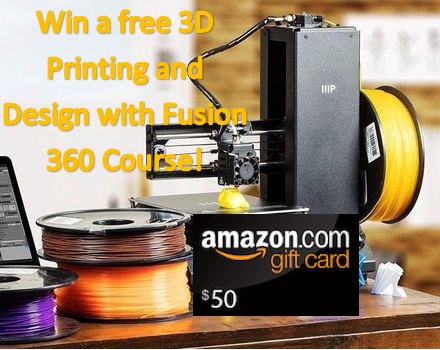
Thanks to our sponsor, Cademy School, we are doing another giveaway. Cademy School has an excellent introduction to Fusion 360 Course. Through this course you will be able to learn about 3D printing and how to design for 3D printing. Basic 3D printing concepts as well as how to optimize your 3D printed parts will be taught. You will learn how to avoid common 3D printing errors and how to make parts with Fusion 360.Cademy is offering not only this course for free during the giveaway but also a $50 Amazon gift card. Second Prize is another Cademy 3D Printing and Design with Fusion 360 Course and a $25 Amazon gift card.
Win through doing any of the following after entering:
- Fill out our 3D printing survey
- Follow us on Facebook
- Follow us on Twitter
- Share on Facebook
- Tweet on Twitter
- Retweet us on Twitter
- Sign up for the 3DPrint.com newsletter
- Subscribe to our YouTube channel
- Visit us on Pinterest
- Sign up for and post in the 3DPrintBoard forum
- Refer friends for extra entries
You can learn more about the course here: 3D Printing and Design with Fusion 360 Course or you can enter the giveaway here.
EOS Unveils M 300-4 DMLS Printer With Specs
German 3D printer manufacturer EOS has just unveiled the latest addition to one of their flagship brands. The M 300-4 DMLS Printer made its debut at the 2018 International Manufacturing Technology Show, with the company touting its vast increase in productivity over the M 290. Much like the other M 300 series’ machines, it uses a laser and […]
The post EOS Unveils M 300-4 DMLS Printer With Specs appeared first on 3D Printing.

